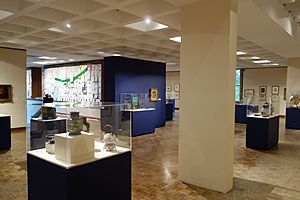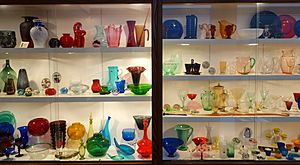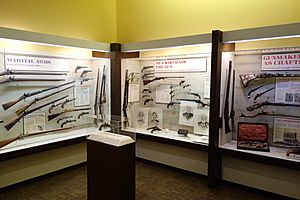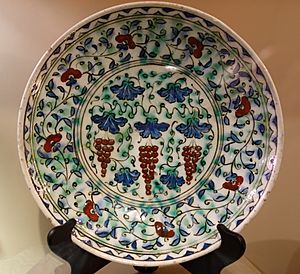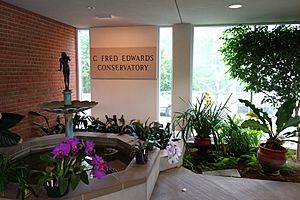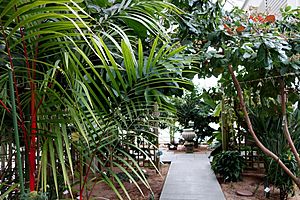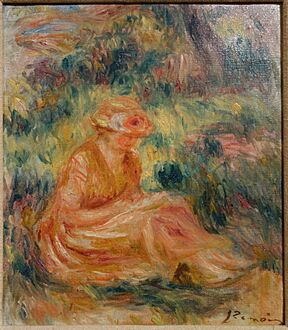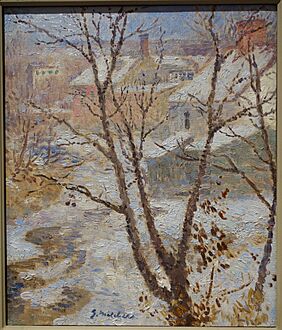Huntington Museum of Art facts for kids
 |
|
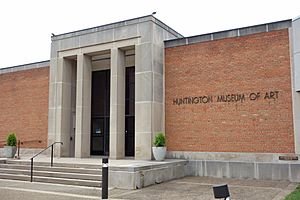
Huntington Museum of Art
|
|
| Established | 1947; opened 1952 |
|---|---|
| Location | 2033 McCoy Road Huntington, West Virginia |
| Type | Art museum |
| Visitors | 50,000+ annually |
The Huntington Museum of Art is a cool place to explore art and nature in Huntington, West Virginia. It's the biggest art museum in the state, covering over 50 acres of land. Inside, you'll find almost 60,000 square feet of amazing art!
The museum has lots of different collections, including paintings, sculptures, and glass art. You can also see unique items like American folk art, Chinese and Japanese objects, and even old firearms. Outside, there are nature trails and a special plant house called the C. Fred Edwards Conservatory. It's a great spot to learn and have fun!
Contents
A Look Back: The Museum's History
The Huntington Museum of Art first started in 1947 and opened its doors in 1952. Back then, it was called The Huntington Galleries. The museum got its current name in 1987.
The land for the museum was a gift from Herbert Fitzpatrick, who also donated over 400 pieces of his own art collection. This included paintings, sculptures, and Asian decorative items. Another important early gift was the Dean Firearms Collection, which is now always on display.
In the 1960s, the museum grew bigger thanks to a gift from the Henry L. and Grace Rardin Doherty Foundation. Famous architect Walter Gropius helped design new parts, like the Grace Rardin Doherty Auditorium and more art studios. Later, the C. Fred Edwards Conservatory was added in the 1990s, filled with tropical plants.
More recently, in 2010, a new gallery was built to honor Isabelle Gwynn Daine and her husband. Mrs. Daine also left money to help the museum bring in exciting new art shows.
Fun Ways to Learn: Educational Programs
Meet the Master Artists Program
The Walter Gropius Master Artist Program brings talented artists to the museum. Since 1992, these artists have shared their skills and ideas. They put on art shows, give talks about how they create, and lead hands-on workshops. It's a great chance to learn from real artists!
Connecting Through Art Programs
The Museum Making Connections (MMC) program offers many ways for kids and adults to get involved with art. These programs happen both at the museum and in local schools. About 28,000 people join these activities every year, helping everyone connect with art.
Amazing Art Collections
The Huntington Museum of Art has almost 17,000 artworks, making it the largest art collection in West Virginia. Many of these pieces were given by generous people from the state.
American Art
This collection features paintings, prints, sculptures, and folk art from America. You can see works by famous artists like Childe Hassam, Robert Henri, John Singer Sargent, Andy Warhol, and Andrew Wyeth. There's even a cool self-portrait bust by sculptor Asa Ames.
Asian Art
Starting with gifts from Herbert Fitzpatrick, the Asian Art collection has grown to include prints, paintings, sculptures, and textiles. It even has a large collection of modern Japanese prints.
European Art
Explore paintings, prints, drawings, and sculptures from Europe. A special highlight is the collection of British silver, with pieces made for important people like the Dukes of Ormonde. You can also see art by Georges Braque, Jean-Baptiste-Camille Corot, Jean-François Millet, Pablo Picasso, and Pierre-Auguste Renoir.
Glass Collection
This is the museum's biggest collection, with over 4,000 glass objects! It shows off glass from ancient times to today, focusing on beautiful pieces made in West Virginia and the Ohio Valley. Don't miss the huge Dale Chihuly glass tower in the C. Fred Edwards Conservatory!
Inuit Art and Sculpture
This small collection of art from the Inuit people was put together in the 1950s by Herman Dean. It mostly features sculptures of figures from the Arctic region of Canada.
British Portraits
The George L. Bagby Collection includes important paintings of people from 18th-century Great Britain. These portraits were created by famous artists like William Beechey, Henry Raeburn, Sir Joshua Reynolds, and George Romney.
The Daywood Collection
Ruth Woods Dayton gave the museum almost 400 artworks, forming the Daywood Collection. It focuses on American art from the late 1800s and early 1900s, including American Impressionism. Mrs. Dayton wanted this collection to stay in West Virginia for everyone to enjoy.
The Herman P. Dean Firearms Collection
Herman Dean's collection shows off many historical firearms, from early hand cannons to weapons from the mid-1800s. It's especially interesting for learning about weapons used on the American frontier, like the Kentucky Rifle. This collection is one of the largest on display in the United States!
The Touma Near Eastern Collection
This collection has over 400 artworks from the Near East, mostly given by Drs. Omayma and Joseph B. Touma. You can see ceramics, glass, paintings, and even old scientific tools. The collection is displayed in its own gallery, which opened in 1996.
The Wilbur Myers Glass Collection
Wilbur Myers loved collecting glass objects from the Victorian era (1837–1901). His collection includes hundreds of vases, bowls, and cups with fancy decorations. Two very rare Morgan vases from this collection were even featured on the TV show Antiques Roadshow!
The Winslow Anderson Collection of Haitian Art
Winslow Anderson was an artist and glass designer who traveled to the Republic of Haiti starting in 1948. He collected art from local painters and metalworkers. His amazing collection of Haitian artworks was given to the museum and continues to grow.
Living Collections: Plants and Animals
C. Fred Edwards Conservatory
Opened in 1996, this special conservatory is the only tropical and subtropical plant house in West Virginia! Besides amazing plants, it's home to animals like koi fish, poison dart frogs, axolotls, and a saltwater aquarium with corals. The plants are grouped into four cool categories:
- Orchids – See dozens of different orchid types from all over the world.
- Agriculturally Important – Discover plants we eat or use, like bananas, chocolate, coffee, and vanilla.
- Fragrant – Smell plants that have strong, unique scents.
- Unusual – Find plants you might not know, like the pitcher plant or the sensitive plant.
Nature Trail System
The museum has over a mile of nature trails, perfect for exploring! These trails have been around since the 1950s and are even part of a national trail system. There are six different paths, including the Teubert Sensory Trail, which is easy for everyone to use. You can also visit the Steelman Butterfly Garden at the start of the trails.
Ancient Discoveries: Archaeological Collections
The museum also holds two important collections of Native American artifacts: The Pitt Stark and The Adams Archaeological Collections. These items were found in West Virginia in the late 1800s and early 1900s. They include tools, animal bones, and pottery pieces. Most of these are kept for researchers to study, but they offer a peek into the past!
Gallery of images
-
Pierre-Auguste Renoir, Young Woman in a Landscape, c. 1915-1919
-
Frank Benson, The Watcher, 1921
See also
 In Spanish: Museo de Arte e Invernadero Huntington para niños
In Spanish: Museo de Arte e Invernadero Huntington para niños
- List of museums in Huntington, West Virginia



